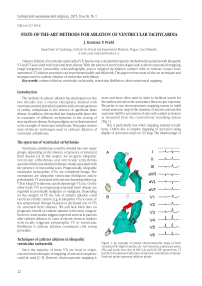State-of-the-art methods for ablation of ventricular tachycardia
Автор: Kautzner Josef, Peichl Petr
Журнал: Сибирский журнал клинической и экспериментальной медицины @cardiotomsk
Рубрика: Обзоры и лекции
Статья в выпуске: 1 т.30, 2015 года.
Бесплатный доступ
Catheter ablation of ventricular tachycardia (VT) has become a standard therapeutic method both in patients with idiopathic VT and VT associated with structural heart disease. With the advent of novel technologies such as electroanatomical mapping, image integration, intracardiac echocardiography, and/or irrigated tip ablation catheter with or without contact force assessment, VT ablation procedure can be performed safely and efficiently. This paper reviews state-of-the-art techniques and strategies used in catheter ablation of ventricular arrhythmias.
Catheter ablation, ventricular tachycardia, ventricular fibrillation, electroanatomical mapping
Короткий адрес: https://sciup.org/14919998
IDR: 14919998 | УДК: 616.127-005.8
Текст научной статьи State-of-the-art methods for ablation of ventricular tachycardia
The method of catheter ablation has developed over last two decades into a routine therapeutic method with enormous curative potential in patients with a broad spectrum of cardiac arrhythmias in the absence of significant heart disease. In addition, this method has irreplaceable place also in treatment of different arrhythmias in the setting of structural heart disease. Both paradigms can be demonstrated in the example of ventricular arrhythmias. This paper reviews state-of-the-art techniques used in catheter ablation of ventricular arrhythmias.
more and more often used in order to facilitate search for the earliest activation site and reduce fluoroscopic exposure. We prefer to use electroanatomic mapping system to build virtual anatomic map of the chamber of interest and use this anatomic shell for annotation of sites with earliest activation as measured from the conventional recording system (Fig. 1).
This is particularly true when mapping isolated ectopic beats. Others like to employ mapping of activation using display of activation times on 3D map. The disadvantage of
The spectrum of ventricular arrhythmias
Ventricular arrhythmias could be divided into two major groups, depending on the absence or presence of structural heart disease [1]. In this respect, we recognize idiopathic ventricular arrhythmias and ventricular arrhythmias associated with structural heart disease, mostly associated with the presence of myocardial scars. Prognostically, idiopathic ventricular tachycardias (VTs) are considered benign. The exemptions are idiopathic ventricular fibrillation and/or polymorphic VT associated with various channelopathies (e.g. VTs in long QT syndrome, catecholaminergic VT, etc). On the other hand, VTs accompanying structural heart disease are regarded as potentially malignant or malignant. Depending on the category of VT, the role of catheter ablation could vary from entirely curative (e.g. in idiopathic VTs) to more or less symptomatic therapy focused on decreased rate of VTs (in structural heart disease). We still lack hard data on prognostic benefit of catheter ablation in the latter category. However, some studies suggest improved survival in patients after catheter ablation. In cases of electric storm in subjects with focally triggered polymorphic VT or ventricular fibrillation is catheter ablation considered a life saving procedure.
Techniques of catheter ablation in idiopathic ventricular tachycardia
Since the majority of these VTs are focal in origin, conventional techniques of mapping of activation sequence could be used [2–5]. However, electroanatomic mapping is
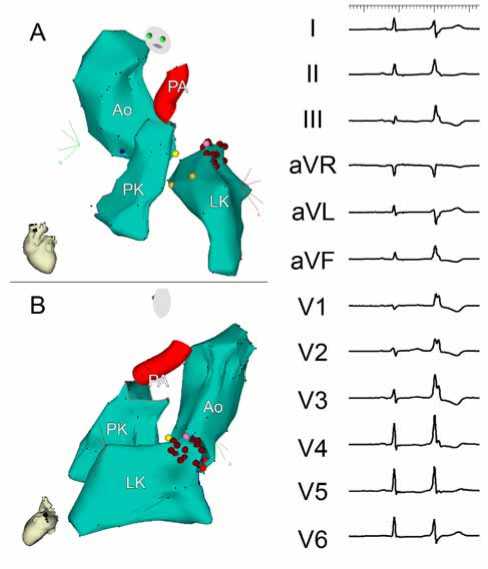
Figure 1. An example of partial electroanatomic maps of both ventricles (PK- Right ventricle, LK – left ventricle), pulmonary artery (PA) and aortic root (Ao) in RAO (A) and LAO (B) projections. 12 lead ECG documents ventricular ectopy from aortomitral continuity. Dark red points represent ablation points
RVOT j
TRA
apex
electroanatomic map
Figure 2. 12-lead ECG of ventricular tachycardia from right ventricular outflow tract (RVOT) in sinus rhythm and during pacing from the ablation catheter (pacemapping). Note similarity of paced QRS morphology with spontaneous arrhythmia. Electroanatomic map of the right ventricle (septal view) documents ablation region below pulmonary valve. Other abbreviations: TRA- tricuspid annulus, apex – right ventricular apex
sinus rhythm
pacing
such approach is possibility to incorporate mapping points at sites where irritation was caused by the catheter tip. This can result in misleading results in pinpointing the earliest activation site. Another mapping strategy is the so-called pacemapping – i.e. pacing from the distal electrode bipole of the mapping catheter with the lowest possible output in order to reproduce morphology of QRS complexes as in arrhythmia (Fig. 2). Some technologies help to make more objective comparison of QRS morphology. One is used in the BARD electrophysiology system, the other, called PASO, is employed in the CARTO 3 system. In addition, various combinations of image integration can be used to improve understanding of anatomy. This is particularly true when mapping aortic root or papillary muscles. Another option is to engage intracardiac echocardiography to facilitate mapping and control catheter contact with the tissue [6]. This is especially true when arrhythmia focus is localized within the cusps of the aortic valve or on papillary muscles or moderator band. When ablation in ventricular myocardium, one can often see lesion formation due to fleeting microcavitation in the heated tissue.
For ablation of idiopathic fascicular VT, the main advantage of the electroanatomic mapping system is that the site of mechanical termination of the arrhythmia can be annotated and used for ablation when mechanical trauma results in subsequent non-inducibility of arrhythmia [7, 8]. In addition, location of the conduction system could be annotated in the left ventricular map along with areas of diastolic potentials in sinus rhythm. The latter could be the alternatively used to guide catheter ablation. Some operators use pragmatic approach and design ablation line across the terminal part of the posterior fascicle.
Techniques of catheter ablation in idiopathic ventricular fibrillation
Catheter ablation has been demonstrated as the method
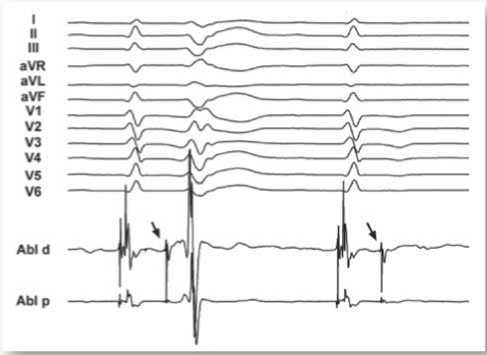
Figure 3. 12-lead ECG during sinus rhythm and ectopic beat of the same morphology that triggered ventricular fibrillation. Note morpohology of the ectopic beat that suggests origin in the conduction system of the left ventricular septum (posterior fascicle). Electrograms from ablation catheter (Abl d and Abl p) show sharp signal preceding local ventricular activation (Purkinje potential) in sinus beat and even much more during the ectopy (left arrow). Right arrow shows the same signal without conduction to ventricle (blocked ventricular extrasystole)
forms of idiopathic ventricular fibrillation [9]. Since the majority of arrhythmic events are triggered from localized ectopic focus within the Purkinje fibres, activation mapping is the best strategy (Fig. 3). More and more operators support this strategy by electroanatomic mapping system [10]. Again, it allows annotation of the site when “bumping” of the ectopic focus occurs during mapping and leads to disappearance of arrhythmia. For foci originating from papillary muscles or the moderator band, intracardiac echocardiography is again very useful [11].
of choice to terminate electrical storm in subjects with various
Techniques of catheter ablation in ventricular tachycardia in structural heart disease
Arrhythmias associated with structural heart disease are mostly related to scar tissue and reentrant in origin. Before the advent of electroanatomical mapping, conventional methods of mapping of activation sequence and/or entrainment mapping were used. However, mapping and ablation during VT was limited to tolerated or relatively tolerated arrhythmias. In 2000, the so-called substrate mapping and modification were described for the first time by the Philadelphia group [12]. It was based predominantly on delineation of a dense scar tissue with bipolar signal amplitude of <0.5 mV, while regions with amplitude >1.5 mV corresponded with normal tissue. Voltage between 0.5–1.5 mV was used to determine scar border zone areas between dense scar and normal tissue. Ablation lesions were placed across the exit zones for different reentrant circuits. Over time, multiple variants of substrate mapping and ablation have been added. In 2003, we described strategy called an integrated approach. In essence, bipolar voltage maps obtained in sinus rhythm or right ventricular pacing are used to annotate all possible sites of interest such as fractionated signals, late potentials and/or pacing spots [13]. Bipolar pacing with the lowest possible output is frequently used in the region of low voltage and/or fractionated or late potentials to assess slow conduction channels and preferential conduction towards the exit site of the scar. Areas of non-capture are annotated in gray in the map by dedicated software when no local bipolar pacing capture is observed at 10 mA (Fig. 4).
In cases of spontaneous occurrence or inducibility of hemodynamically tolerated VT, limited activation mapping can be performed to confirm participation of previously identified slow conducting channels in reentrant circuit. Entrainment mapping is used in different regions of the circuit. Alternative strategies rely mainly on assessment of late potentials or local abnormal ventricular activities [14]. Catheter ablation then targets such regions in order to abolish all late potentials or LAVA. Some operators use predominantly pacemapping and analysis of similarity of QRS morphology at different sites of the substrate with clinical arrhythmia [15, 16]. Others propose image integration of electroanatomical maps with 3D reconstruction of a substrate using MRI with late gadolinium enhancement. More recently, intracardiac echocardiography is more and more often used to visualize myocardial substrate on line [17]. (Fig. 5).
Based on our experience, intracardiac echocardiography is particularly advantageous in patients after correction of congenital heart disease [18].
Since some disease entities (eg arrhythmogenic right ventricular dysplasia or dilated cardiomyopathy) have substrate localized mainly epicardially, technique of epicardial puncture and mapping has been developed [19]. Electroanatomical mapping of epicardial surface is often performed to display regions of the scar tissue and annotate points of interest [20, 21]. When an epicardial approach was used, coronary angiogram is performed to avoid application of radiofrequency energy in the vicinity of the epicardial coronary vessels. Alternatively, image integration could be used
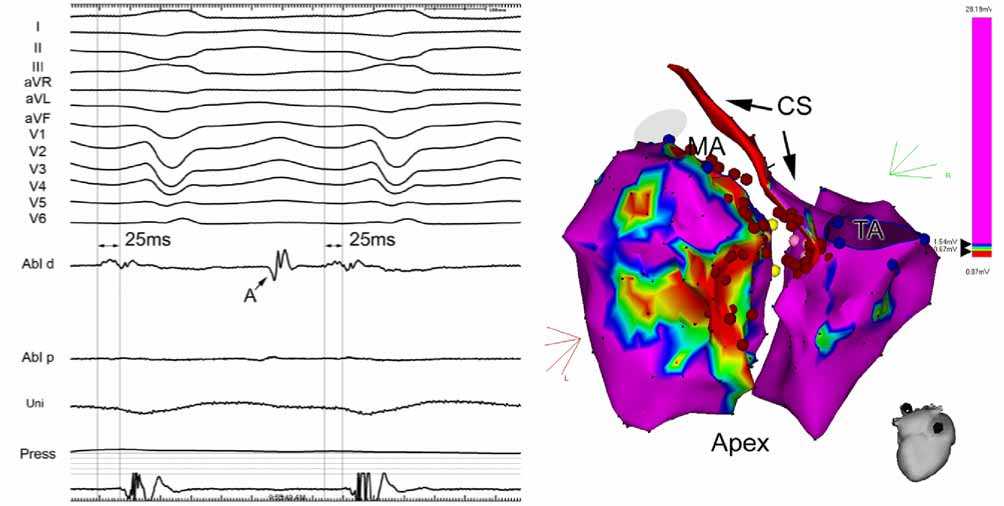
Figure 4. Electroanatomic voltage map of the left ventricle (RAO view) showing large substrate after anteroseptal myocardial infarction (red-gren color). Minimum voltage is as low as 0.23 mV, allowing to delineate channels of surviving tissue within the scar (yellow to green regions). Grey zones show sites of non-capture. Arrows depict 4 critical isthmuses for 4 different morphologies of ventricular tachycardia that were induced (corresponding morphologies are below). Dark red points depict lines of ablation leading to homogenization of the substrate and non-inducibility of all ventricular tachycardias. Abbreviations: MA – mitral annulus, Apex – apical region, Anterior – anterior wall
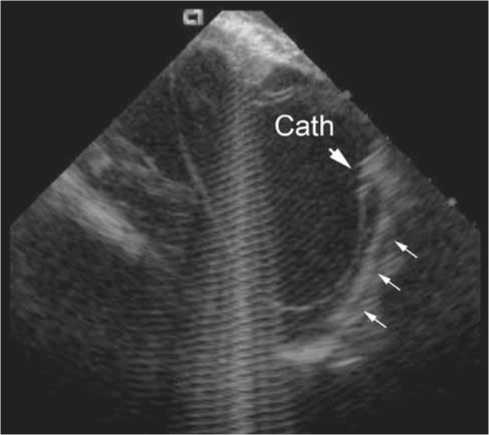
Figure 5. Intracardiac echocardiogram of the left ventricle (obtained from the right ventricular cavity) depicting large aneurysm of the anterior wall with endocardial scar replacing the half of the thickness of myocardium (small arrows). Ablation catheter is introduced retrogradely and bended against the wall (Cath with arrow)
with fusion of prerecorded CT image of the left ventricle and coronary arteries. The use of catheter with contact force sensing and vector of force display allows to confirm adequate contact force with epicardium. Indication for epicardial mapping could arise from endocardial unipolar maps of either right or left ventricles [22, 23]. Suspicion on epicardial substrate can be Epicardial substrate could be assessed also by intracardiac eachocardiography [24].
Techniques of catheter ablation in ventricular fibrillation associated with structural heart disease
Catheter ablation has been demonstrated as the method of choice to terminate electrical storm in subjects with various forms of ventricular fibrillation in patients with structural heart disease, especially ischemic heart disease. Also in such cases, the majority of arrhythmic events are triggered from the Purkinje fibres surviving within the region of myocardial necrosis or scar. Such arrhythmic focus is usually localized close to the borderzone with normal tissue. For this reason, the use of electroanatomic mapping system proved to be very useful [25, 26]. It allows annotation of the site when “bumping” of the ectopic focus occurs during mapping and leads to disappearance of arrhythmia (Fig. 6). Empirical ablation could be performed around the borderzone of the scar or necrosis.
Technology focused on more efficacious ablation
Regarding energy sources, radiofrequency current remains still the most widely used. To improve the efficacy of ablation, several modifications of the catheter tip electrode have been introduced.
Large-tip electrodes. One approach to enlarge the lesion size is to increase the electrode surface area exposed to the
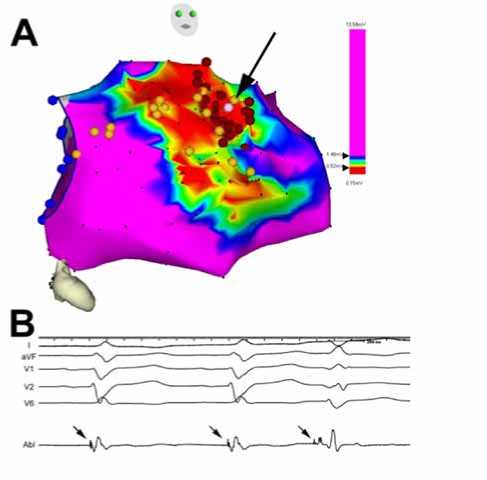
Figure 6. A. Electroanatomic voltage map of the left ventricle (RAO) in subacute stage of anteroseptal myocardial infarction complicated by electrical storm due to focally triggered ventricular fibrillation. Red color depicts necrotic region, yellow points delineate conduction system. Large arrow shows the site of triggering focus in anterior fascicle, dark red points correspond to ablation points around to modify the region. B. ECG leads I, aVF, V1,2,and 6 together with signal from ablation catheter (Abl) during endocardial mapping. Arrows depict sharp Purkinje potential that is earliest during triggering ectopic beat (third beat from left)
blood. The result is higher convective cooling of the catheter tip, allowing delivery of more energy to the tissue. Today, catheters with electrode tip of 8–10 mm are available and used in clinical practice [27, 28]. On the other hand, nonuniform heating around the electrode increases a risk of coagulum formation at the base of the electrode. Additionally, large-tip electrodes decrease accuracy of mapping due worse spatial resolution.
Gold-tip electrodes. Another strategy to achieve larger lesions is to use gold electrodes. Gold exhibits a thermal conductivity of nearly four times greater than platinumiridium (3.17W/cm Kelvin vs. 0.715W/cm Kelvin). RF ablation with such electrode results in broader and deeper lesions as a result of a better heat conduction from the tissue-electrode interface and additional cooling of the gold electrode by “heat loss” to the intracardiac blood [29].
Irrigated tip electrodes. An alternative strategy to create larger RF lesions comprises active cooling of the electrode tip at the tissue inter- face. This can be accomplished by irrigation of the electrode tip with saline solution. When the electrode-tissue interface is cooled, power can be increased without concern about the surface temperature exceeding 100 °C and coagulum form- ing. This effect does not directly lead to increased lesion dimension. Convective cooling of the electrode tip results in energy dissipation into the circulating blood pool. When the energy loss is not matched by increased energy delivery from the RF generator, lower net energy is transmitted to the tissue, and lesion size could be smaller [30].
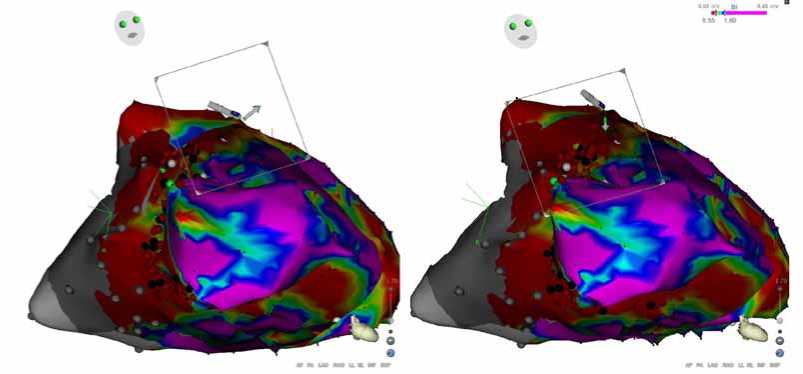
Figure 7. Electroanatomic maps of endocardial and epicardial surface of the left ventricle (RAO views, epicardial map partly cut to open view inside) during catheter ablation with Smart Touch catheter. Small vector (grey arrow) shows direction of the force – on left panel pointing away from epicardial surface and on right panel towards epicardial surface
Needle tip electrode. Recently, early clinical work was introduced to increase lesion size, especially depth. So far, only feasibility studies have been performed [31].
Contact force technology . Recently, contact force (CF) between the catheter tip and the myocardium has been identified as one of the important determinants influencing RF lesion size [34, 35]. Currently, three novel technologies are available to assess real-time catheter-tissue CF. Historically the first one, called Intellisense, was implemented in the electromechanic robotic system Sensei (Hansen Medical, inc, Mountain View, CA), and consisted of indirect assessment of catheter tip-tissue contact through measurement of friction in the proximal part of catheter shaft [36]. In principle, the remote catheter manipulator directly controls a hollow robotically steered sheath (Artisan Catheter, Hansen Medical) that can accommodate any mapping or ablation catheter. Small catheter movements inside the sheath create friction. The intensity of the friction is proportional to the CF.
Two other technologies use direct measurement of the catheter tip contact through a specific sensor. One system employs 3 optical fibers to measure microdeformation of a deformable body in the catheter tip (TactiCath; St Jude Medical, Inc) [34, 37]. The second type of catheter uses a small spring connecting the ablation tip electrode to the catheter shaft with a magnetic transmitter and sensors to measure small deflections of the spring (Theromocool SmartTouch; Biosense Webster, Inc). This technology allows construction of 3D electroanatomical maps of CF distribution.
Currently, there is little evidence on clinical utility of CF for VT ablation. Our experience showed that retrograde approach to the left ventricle results in high CF in the region of the lateral and posterolateral wall. On the other hand, transseptal approach allows for better distribution of CF along the interventricular septum, inferior wall and the outflow tract. The above observations were quantified in a technical study in which both antegrade-transseptal and retrograde-transaortic LV-mapping approach were compared in 10 patients undergoing VT ablation by using CF-sensing catheters [38]. Operators were blinded to CF data and data were analysed according to 11 predefined left ventricular segments. CF was significantly higher antegradely in mid-anteroseptum, midlateral, and apical segments, and significantly higher retrogradely in basal-anteroseptum, basal-inferoseptum, basal-inferior, and basal-lateral segments. Contact force did correlate with impedance, unipolar, and bipolar electrogram amplitudes; however, there were large overlaps. For epicardial ablation, CF vector that is available in SmartTouch technology clearly identifies whether the tip of the catheter is in a contact with epicardial surface (Fig. 7).
Conclusion
Catheter ablation of ventricular arrhythmias has developed over last two decades significantly. With current mapping, imaging and catheter technologies, catheter ablation can be considered as highly efficient in treatment of idiopathic VTs. In this indicaton, it is considered curative. In subjects with structural heart disease, current technologies allow successful modification of arrhythmogenic substrate in a high proportion of patients, regardless of hemodynamic tolerability of arrhythmias. It is preferred therapeutic method in patients with electrical storm. This is particularly true in cases of focally triggered ventricular fibrillation. Some preliminary data suggest that catheter ablation can be performed in patients with structural heart disease even prophylactically.
Supported by a Research Grant No MZO 00023001 of the Ministry of Health of the Czech Republic
Список литературы State-of-the-art methods for ablation of ventricular tachycardia
- Aliot E.M., Stevenson W.G., Almendral-Garrote J.M. et al. EHRA/HRS Expert Consensus on Catheter Ablation of Ventricular Arrhythmias: developed in a partnership with the European Heart Rhythm Association (EHRA), a Registered Branch of the European Society of Cardiology (ESC), and the Heart Rhythm Society (HRS); in collaboration with the American College of Cardiology (ACC) and the American Heart Association (AHA)//Europace. -2009. -Vol. 11. -P. 771-817
- Hoffmayer K.S., Gerstenfeld E.P Diagnosis and management of idiopathic ventricular tachycardia//Curr. Probl. Cardiol. -2013. -Vol. 38. -P. 131-158.
- Prystowsky E.N., Padanilam B.J., Joshi S., Fogel R.I. Ventricular arrhythmias in the absence of structural heart disease//J. Am. Coll. Cardiol. -2012. -Vol. 59. -P. 1733-1744.
- Yamada T., Kay G.N. Optimal ablation strategies for different types of ventricular tachycardias//Nat. Rev. Cardiol. -2012. -Vol. 9. -P. 512-525.
- Schreiber D., Kottkamp H. Ablation of idiopathic ventricular tachycardia//Curr. Cardiol. Rep. -2010. -Vol. 12. -P. 382-388.
- Kautzner J., Peichl P. 3D and 4D echo-applications in EP laboratory procedures//J. Interv. Card. Electrophysiol. -2008. -Vol. 22. -P. 139-144.
- Nogami A. Purkinje-related arrhythmias part I: monomorphic ventricular tachycardias//Pacing Clin. Electrophysiol. -2011. -Vol. 34. -P. 624-650.
- Ramprakash B., Jaishankar S., Rao H.B., Narasimhan C. Catheter ablation of fascicular ventricular tachycardia//Indian Pacing Electrophysiol. J. -2008. -Vol. 8. -P. 193-202.
- Hanssaguerre M., Shah D.C., Jais P. et al. Role of Purkinje conducting system in triggering of idiopathic ventricular fibrillation//Lancet. -2002. -Vol. 359. -P. 677-678.
- Kleissner M., Peichl P., Kautzner J. Idiopathic ventricular fibrillation triggered by two distinct foci//Europace. -2014. -Vol. 16. -P. 1459.
- Sadek M.M., Benhayon D., Sureddi R. et al. Idiopathic ventricular arrhythmias originating from the moderator band: Electrocardiographic characteristics and treatment by catheter ablation//Heart Rhythm. -2015. -Vol. 12. -P. 67-75.
- Marchlinski F.E., Callans D.J., Gottlieb C.D. et al. Linear ablation lesions for control of unmappable ventricular tachycardia in patients with ischemic and nonischemic cardiomyopathy//Circulation. -2000. -Vol. 101. -P. 1288-1296.
- Kautzner J., Cihak R., Peichl P. et al. Catheter ablation of ventricular tachycardia following myocardial infarction using three-dimensional electroanatomical mapping//Pacing Clin. Electrophysiol. -2003. -Vol. 26(1 Pt. 2). -P. 342-347.
- Jais P., Maury P., Khairy P. et al. Elimination of local abnormal ventricular activities: a new end point for substrate modification in patients with scar-related ventricular tachycardia//Circulation. -2012. -Vol. 125. -P. 2184-2196.
- De Chillou C., Groben L., Magnin-Poull I. et al. Localizing the critical isthmus of postinfarct ventricular tachycardia: the value of pace-mapping during sinus rhythm//Heart Rhythm. -2014. -Vol. 11. -P. 175-181.
- De Chillou C., Magnin-Poull I., Andronache M. et al. Showing up channels for postinfarct ventricular tachycardia ablation//Pacing Clin. Electrophysiol. -2012. -Vol. 35. -P. 897-904.
- Hussein A., Jimenez A., Ahmad G. et al. Assessment of ventricular tachycardia scar substrate by intracardiac echocardiography//Pacing Clin. Electrophysiol. -2014. -Vol. 37. -P. 412-421.
- Grieco D., Peichl P., Cihak R., Kautzner J. Successful ablation of ventricular tachycardia after correction of tetralogy of Fallot//Herzschrittmacherther Elektrophysiol. -2014. -Vol. 25. -P. 116-120.
- Sosa E., Scanavacca M., d’Avila A. et al. Nonsurgical transthoracic epicardial catheter ablation to treat recurrent ventricular tachycardia occurring late after myocardial infarction//J. Am. Coll. Cardiol. -2000. -Vol. 35. -P. 1442-1449.
- Sarkozy A., Tokuda M., Tedrow U.B. et al. Epicardial ablation of ventricular tachycardia in ischemic heart disease//Circ. Arrhythm. Electrophysiol. -2013. -Vol. 6. -P. 1115-1122.
- Della Bella P., Brugada J., Zeppenfeld K. et al. Epicardial ablation for ventricular tachycardia: a European multicenter study//Circ. Arrhythm. Electrophysiol. -2011. -Vol. 4. -P. 653-659.
- Polin G.M., Haqqani H., Tzou W. et al. Endocardial unipolar voltage mapping to identify epicardial substrate in arrhythmogenic right ventricular cardiomyopathy/dysplasia//Heart Rhythm. -2011. -Vol. 8. -P. 76-83.
- Hutchinson M.D., Gerstenfeld E.P., Desjardins B. et al. Endocardial unipolar voltage mapping to detect epicardial ventricular tachycardia substrate in patients with nonischemic left ventricular cardiomyopathy//Circ. Arrhythm. Electrophysiol. -2011. -Vol. 4. -P. 49-55.
- Bala R., Ren J.F., Hutchinson M.D. et al. Assessing epicardial substrate using intracardiac echocardiography during VT ablation//Circ. Arrhythm. Electrophysiol. -2011. -Vol. 4. -P. 667-673.
- Peichl P., Cihak R., Kozeluhova M. et al. Catheter ablation of arrhythmic storm triggered by monomorphic ectopic beats in patients with coronary artery disease//J. Interv. Card. Electrophysiol. -2010. -Vol. 27. -P. 51-59.
- Szumowski L., Sanders P., Walczak F. et al. Mapping and ablation of polymorphic ventricular tachycardia after myocardial infarction//J. Am. Coll. Cardiol. -2004. -Vol. 44. -P. 1700-1706.
- Feld G., Wharton M., Plumb V. et al. Radiofrequency catheter ablation of type 1 atrial flutter using large-tip 8-or 10-mm electrode catheters and a high-output radiofrequency energy generator: results of a multicenter safety and efficacy study//J. Am. Coll. Cardiol. -2004. -Vol. 43. -P. 1466-1472.
- McRury I.D., Panescu D., Mitchell M.A. et al. Nonuniform heating during radiofrequency catheter ablation with long electrodes: monitoring the edge effect//Circulation. -1997. -Vol. 96. -P. 4057-4064.
- Lewalter T., Bitzen A., Wurtz S. et al. Gold-tip electrodes -a new “deep lesion” technology for catheter ablation? In vitro comparison of a gold alloy versus platinum-iridium tip electrode ablation catheter//J. Cardiovasc. Electrophysiol. -2005. -Vol. 16. -P. 770-772.
- Wittkampf F.H., Nakagawa H. RF catheter ablation: Lessons on lesions//Pacing Clin. Electrophysiol. -2006. -Vol. 29. -P. 1285-1297.
- Sapp J.L., Beeckler C., Pike R. et al. Initial human feasibility of infusion needle catheter ablation for refractory ventricular tachycardia//Circulation. -2013. -Vol. 128. -P. 2289-2295.
- Koruth J.S., Dukkipati S., Miller M.A. et al. Bipolar irrigated radiofrequency ablation: a therapeutic option for refractory intramural atrial and ventricular tachycardia circuits//Heart Rhythm. -2012. -Vol. 9. -P. 1932-1941.
- Gizurarson S., Spears D., Sivagangabalan G. et al. Bipolar ablation for deep intra-myocardial circuits: human ex vivo development and in vivo experience//Europace. -2014. -Vol. 16. -P. 1684 1688.
- Yokoyama K., Nakagawa H., Shah D.C. et al. Novel contact force sensor incorporated in irrigated radiofrequency ablation catheter predicts lesion size and incidence of steam pop and thrombus//Circ. Arrhythmia Electrophysiol. -2008. -Vol. 1. -P. 354-362.
- Shah D.C., Lambert H., Nakagawa H. et al. Area under the realtime contact force curve (force-time integral) predicts radiofrequency lesion size in an in vitro contractile model//J. Cardiovasc. Electrophysiol. -2010. -Vol. 21. -P. 1038-1043.
- Di Biase L., Natale A., Barrett C. et al. Relationship between catheter forces, lesion characteristics, “popping,” and char formation: experience with robotic navigation system//J. Cardiovasc. Electrophysiol. -2009. -Vol. 20. -P. 436-440.
- Nakagawa H., Kautzner J. et al. Locations of high contact force during left atrial mapping in atrial fibrillation patients: electrogram amplitude and impedance are poor predictors of electrode-tissue contact force for ablation of atrial fibrillation//Circ. Arrhythm. Electrophysiol. -2013. -Vol. 6. -P. 746-753.
- Tilz R.R., Makimoto H., Lin T. et al. In vivo left-ventricular contact force analysis: comparison of antegrade transseptal with retrograde transaortic mapping strategies and correlation of impedance and electrical amplitude with contact force//Europace. -2014. -Vol. 16. -P. 1387-1395

